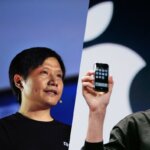Screenshots are often produced to represent the best part of movies. These permanent, still image touches upon people because of their interaction with the movie a month, two years or even ten years ago.
A popular app in China is now changing this simple logic between movies and screenshots and they are undoubtedly getting very close to success. Fotoplace, which sounds exactly like “Photoplace”, is an image-based social networking app that provides people information about the scenic spots or movies shot in their current location, encourages people to take pictures and collage them with the scenes in movies or old photos of their own and “live your own movie”.
On February 3rd, Fotoplace introduced their new function, “Wide Screen Mode”(which is then modified to “Movie Mode”), which provided a quick and easy way for the users to create a film-like scene out of ordinary photos, with two simple features: subtitle adding and black screening.
On the following day, over one thousand new users downloaded Fotoplace.
On March 13th, the user number of Fotoplace has reached 180,000.
In the following week, the user number of Fotoplace is increasing in an incredible speed.
On March 15th, Fotoplace’s user number climbed over 1,000,000 and the story continues.
On March 22nd, this number became 10,000,000.
Fotoplace remains the most downloaded free app in the Chinese app store through out mid March. The ranking starts to fall back from March 26th and now it stays at around 40th place. Notably, there is a drastic drop down of its rating on April 12th because a major issue appeared after their update for the iOS version.
Compared with other functions that require the user to have certain amount of movie knowledge, childhood photos that they feel related to, or a chance to visit the places in movies, the production of “Wide Screen/Movie Mode” seems really simple.
1. You might take a picture when you are throwing garbage in a lonely night, finding yourself in a creative mood.
Photo by Shibei Ding
2. Black screen it. All of a sudden two garbage bags and a limited portion of human hand start to create a scene full of emotion.
Photo shoot and created by Shibei Ding
3. Here comes my favorite part. Subtitles. The fun thing is that you can play with the Chinese subtitle/subtitle of your own language and the English title. In this picture the Chinese subtitle says “Routine workout” whereas the English subtitle goes as “Lone garbage ranger”. This subtle form of sarcasm brings much fun to the creating process.
Photo shoot and created by Shibei Ding
It is not a rare phenomenon for apps created by little known developers suddenly attracted enormous amount of attention. Photo editing app like MYOTee and Moment Cam are all Fotoplace’s predecessors, all of which vanished from the app ranking and some of them stopped updating for over six months.
However, there are two features that might keep Fotoplace alive.
Firstly, the core of this app is its social networking potential. As the founder Liu Yang said during Tencent’s interview, Fotoplace aims to “create a storyline” in the users’ life so that their followers can develop a closer connection with their posts instead of laughing about one image and forgetting it over the second one. To focus more on the social networking function of Fotoplace, two major features were deleted after the sudden increase of user number because of the widescreen mode.
Secondly, unlike the two apps mentioned above that provide set figures for the users, Fotoplace only provides a frame for its users while the content are left for them to fill in. A developer can prepare a thousand funny filters for the users, but there will be a day that they get bored of them all. Creating one’s own image, however, makes this process much slower.

































